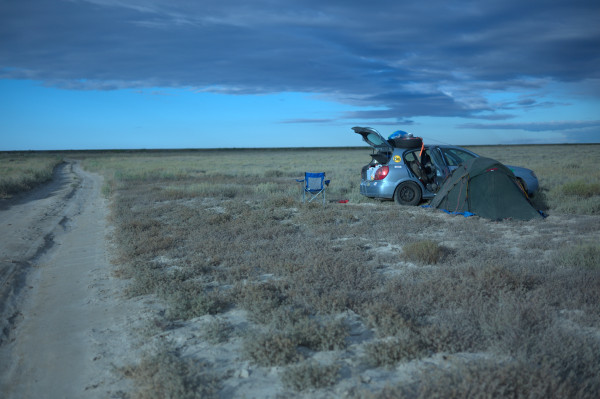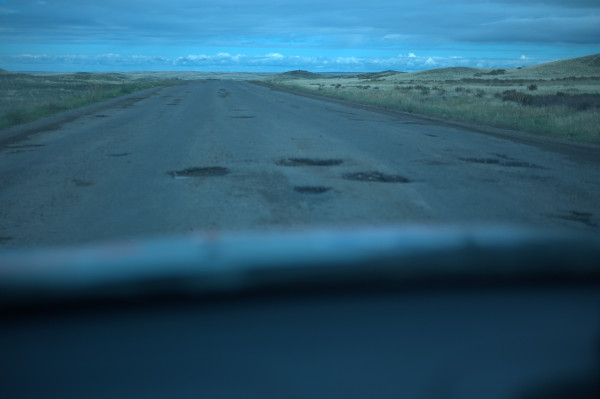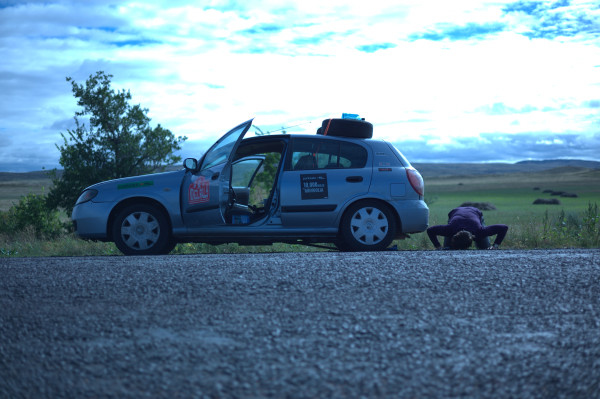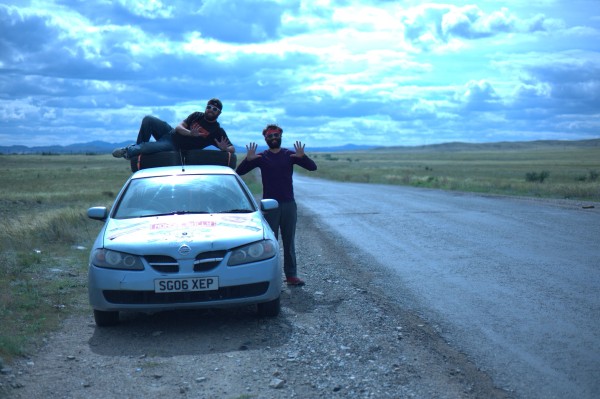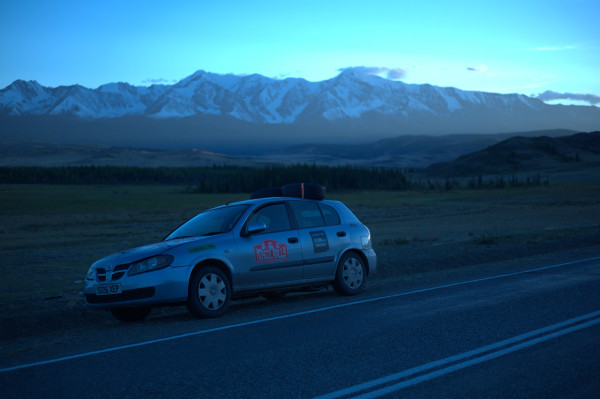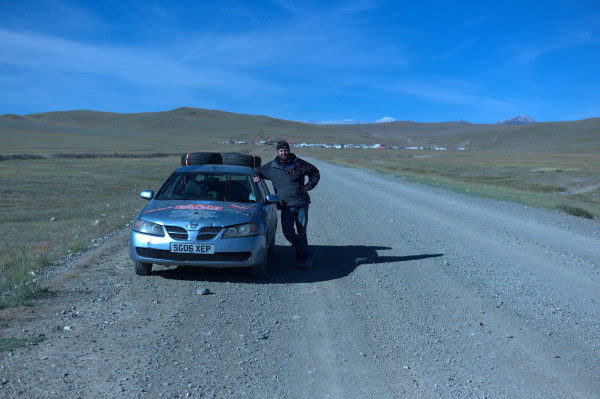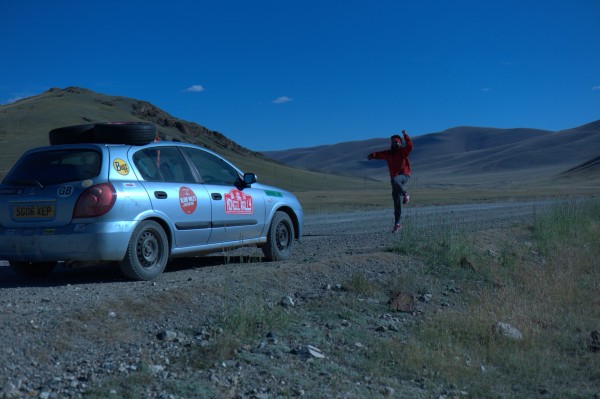2013.08.30 — Friday — The day had finally arrived. After two weeks in Almaty waiting for Jon Hay to get fixed and to acquire new Russian visas, we were finally poised to hit the road again. The final hurdle was to stop by the Russian consulate (for a fourth time) to pick up our passports, which we hoped would contain new Russian visas. It took a little longer to enter this time, but once inside we were practically trained professionals. We made our way to Window 3 and saw the now familiar face of the man who, despite sending us away twice (and thus delaying us a week), was always very nice and welcoming. He knew exactly who we were and why we were there and this time he actually had what we wanted. With passports in hand and visas in order, we filled up on gas, grabbed one last bite of the Almaty fare, and set out north through Kazakhstan. It was surreal to be back on the road after such a long layover. Our road took us past some large lakes, through some bogs, and along some pretty serious snow-capped peaks to the East. These peaks were apparently off limits, we would later learn, as ralliers were arrested there for violating the Chinese frontier — something Attila The Pun would never do. We drove steadily until the light waned, then pulled off down a dirt road and prepared for our twentieth night in Kazakstan. We hit the ramen hard and pondered the type of creature which might be responsible for digging the holes which peppered the ground in every direction. The mystery remains intact for Mongol Rally 2014.
2013.08.31 — Saturday — The new day represented our 21st in the great nation of Kazakhstan, but we were determined to not eclipse the three week mark. We wound our way north and west along roads which varied greatly in quality; most were made of old, disintegrated asphalt which featured hazardous ridges and potholes.
Despite the obvious perils within the road, we were doing a good job of navigating around any forms of danger when all of a sudden, out of nowhere our car started making a loud scraping noise. To be clear, loud scraping noises were very common for us — with the weight of the car, we were often scraping the bottom on all sorts of different imperfections in the road. This time, however, the scraping noise persisted. We stopped and had a look under the car.
Our guard, which had so admirably protected Jon Hay’s undercarriage since its installation in Astrakhan, was now only attached in the front while the back hung on the ground. There was a hole in the piece of metal where the screw had been, so we fastened three zip ties together, looping one though the hole in the metal and another around our rear axle, but every time we tried to tighten the zip ties one of them broke. After several efforts, it became clear that this was not going to work. We either need to come up with another solution or find a way to remove the guard entirely. After some serious debate, we decided to try out a bungee cord. We hooked on end through the hole in the guard, wrapped the cord multiple times around the axle and then fastened the other end to the side of the car, forming a v-shape with the cord that held up both rear corners of the guard. Low and behold, this worked! Well, it worked in the sense that we made it at least 5 miles before the sharp edge of the guard sheered it’s way through the bungee and the guard began to drag again. We went back to work under the car, this time using duct tape to create a buffer between the (second) bungee and the guard and once again hit the road. It was never without doubt going forward, but the bungee/duct tape combo seemed to do the trick. We pressed onward along a long stretch where the road was newly paved as well as long portions where the road was in the process of being repaved. Of course, when the roads are in the process of being repaved, they divert cars to dirt roads that are even more of a mess than the standard old potholed Kazakh roads. Somewhere along that portion of the road, Jon Hay struck the momentous 10,000-mile mark and so we stopped to commemorate the occasion.
By about 6 PM, we found our way to the city of Semey, the last major Kazakh city about 115 kilometers from the border. We executed our standard three loops around a roundabout as we tried to figure out which of the listed cities would take us in a suitable direction (northish). We eventually peeled off for our final run at the border. Whereas the entirety of Kazakhstan had been primarily flat and dry with little vegetation, the area approaching the border was rich with trees and lakes. It was almost like we were in an entirely new country…almost. The poorly paved roads brought us back, however, and reminded us that we were still in Kazakhstan. We reached the border just before 8 PM and, other than a few directional miscues as to where we were supposed to go, made it through the Kazakh side with relative ease. We then waited in a queue for an hour to enter the Russian side, but again, once there, we passed through fairly quickly. All in all it took about two hours and it was just about 10 PM when we set out to find camp in Russia. The first thing we noticed was that the roads were perfectly lined and paved. That was certainly not something to be taken for granted anymore. These beautiful roads led us into a small city called Rubovsk. Navigating through the city came with all of the standard challenges we had come to expect. It generally goes like this: the road you’re on leads directly into the heart of the city and without the guidance of any signs, you’re supposed to find your own way out the other side. This usually involves (among other things): following the best-paved (or only paved) road, following the road with the most street lights, following the road with the most traffic, and of course, always keeping the car oriented so that compass needle is pointed in the right direction. Fortunately there aren’t many roads leading into or out of these cities, so once you manage to punch through the center things get simpler. After a few U-turns and some backtracking and some circling we found ourselves on a road leading north out of Rubovsk, and we were confident we were on the right track. It had been completely dark since we’d entered Russia, so we had no idea what we were driving through, which made finding a campsite difficult. As soon as we found a small turnoff we parked Jon Hay and slept in the car. The night was very cold and so we had to fire up Jon Hay on several occasions for heat.
2013.09.01 — Sunday — Dawn was marked by the sound of birds landing and walking on our roof — they had taken interest in Jon Hay’s spare tires. The sleep wasn’t great and we still had a lot of road to travel, so when the first light shown above the horizon (about 6:30 AM, which had been 5:30 AM before the time change entering Russia) we hit the road. We continued north to Barnaul and navigated our way around the city, thus ending the “North to Russia” leg of the trip and commencing the ultimate easterly push towards Ulaanbaatar. Barnaul was the furthest north we’d been since our prelaunch jaunt up to Scotland. We stopped for gas just before Gorno-Altaesk and were permitted to begin filling our tank after handing over a credit card. However, it wasn’t until the tank was full that we found that they could not process the card…or any of our other cards. We had about 500 rubles from our first run through Russia, but the bill was 1,750 rubles. We showed them US dollars (which had been accepted pretty much everywhere when we were in a pinch), but that was a no-go as well. Ultimately we had to leave Ian behind as collateral while Matt followed a hand drawn map to the nearest town where he was able to find some sort of store that supposedly had an ATM.
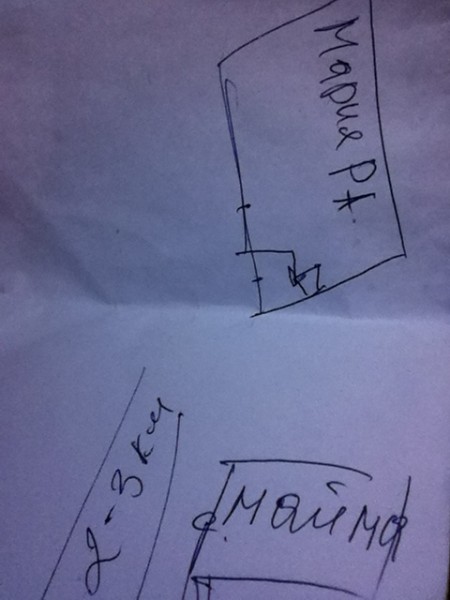
Translation: Go 2-3 km. When you pass a sign for the city Майма, look for a store called Mapus PA. Go in the front door and the ATM will be on your right.
The first store Matt found had an ATM-sized machine with slots for cards/money, but screen-wise looked nothing like an ATM. It wasn’t. Was this where he was supposed to go? Did the person who drew the map think Matt could get money here? Regardless, an ATM needed to be found so Matt continued on. The name of the second store he found corresponded a lot better with the words on the map and, low and behold, there was something that looked exactly like an ATM inside. Money was withdrawn, cranky/upset gas attendants were paid, Ian was retrieved and Jon Hay was back on the road with a full tank of gas. We were under the impression that eastern Russia was a very desolate place, but in reality there are towns everywhere and the landscape is quite beautiful. Our road through the Altai Mountains followed a wide, blue river and took us through thick forests and expansive, rolling meadows, all set against the snowy peaks.
Along the way we happened upon another Rally team who had stopped to enjoy the scenery and drink a cup of tea. This was the first team we’d encountered since the Pamirs. There were probably only ten or so teams still on the road, so encounters such as these were rare. They were an Irish fellow and a Spanish girl — their third teammate, another Irishman, had recently thrown in the towel and flown home. They had traveled south from London through Turkey, Iran and Turkmenistan (to name a few) and had very interesting stories from their stops in these places. Unlike us, however, they had yet to experience car issues or any other sorts of delays for that matter; they were simply taking their time. We relaxed with them for a while over some wine, tea, bread, and honey, and then we took a swim in a nearby stream as some Russian kids looked on. We were about three hours from the Russian/Mongol border, but they had no interest in going that day…and maybe not even the next. For us, the thought of finally reaching Mongolia after everything we’d been through had us like horses headed for the stables. We thus bid our new friends farewell and headed on our way. After two more hours of driving, Mongolia was practically within our reach, but we knew the border was closed until 9 AM the following morning. So when we stumbled across our first legitimate campsite we stopped for the evening. It was nice to find a flat, comfy grassy area for our tent (right by a stream and some rolling hills), but we were back at 7,000 feet and pushing autumn, so it was once again very cold. After a quick meal we crawled into our sleeping bags and drifted off to sleep.
2013.09.02 — Monday — We were awoken very early the next morning by a Russian fisherman. The stream on which we were camped was perfectly accessible for hundreds of meters, but our fisherman decided we had camped in the best spot; he set up shop meters from our tent and started casting his line. We got up and attempted to engage him, but his grunts implied he had little interest. The Russia/Mongolia border takes a notoriously long time for members of the Mongol Rally (primarily due to issues with having to import the car); some have made it through in four hours, others have taken four days. We wanted to reach the border before it opened at 9AM so we wasted little time getting back on the road. We drove the final hour to Tashanta, filled up on gas and made it to the border at 8:55 AM. We were approximately the sixth car in line. Around 9:30 AM they let the first car pass into the border control zone At 9:45 AM someone in front of us walked back and knocked on our window. We didn’t understand him as he spoke in Russian, but he pointed towards the border and crossed his arms to indicate “no”. He then pointed back behind us and said something that sounded like “immigration” so we thanked him and headed back from whence we came. On our first pass back through Tashanta we didn’t see anything that might resemble an immigration office. When it seemed clear we’d gone too far, we doubled back towards the border again and stopped at a very tiny building with a couple people standing around it. We walked up to the door and sure enough there was a small plaque in Russian that read something that sounded like “immigration”. Inside, the guy looked at our passports, stamped a piece of paper we’d received when entering the country, and sent us back to the border. We arrived at the border for a second time at about 10:15 AM. Several cars had already passed through the gates and only one new car had entered the queue, so we were now fourth in line. It wasn’t long before they let all four of us in and people seemed to unload out of every nook and cranny of two of the vehicles. There must have been ten people in each of the cars. A border official sent Ian one way to deal with the car info and Matt another way to go through passport control. Unfortunately, by the time Ian was done with the car, he was last in a line of 25 people for passport control. That process took 1.5 hours and then we had to unload our entire car for a drug-sniffing dog. Deemed to be clean, we reloaded our slobber-ladened things into our car and finally passed through the Russian side of the border; it was just after noon. We drove a fairly unexciting 20 miles between borders where the only thing of note was a gate which must have symbolized the cross from Russian No Man’s Land to Mongolian No Man’s Land, and also the transition from nice paved roads to rocky dirt roads. At the gate to the Mongolian border was a woman who checked our car registration and also ran a money exchange. She probably made a pretty penny on the conversion rates, but we were happy to part with our Kazakh tenge and Russian rubles. She let us through the gate and the Mongolian border officially began. By this time, the cars ahead of us were either already gone or almost done, so the process was pretty quick. The people were nice and spoke pretty solid English. We got our passports stamped and they checked the contents of the car and directed us to one final window. Could it really be this quick? Of course not. The person at the final window had already left for lunch, and didn’t return for another 1.5 hours. At about 2 PM we began the final step, the immigration process. People came, they checked our documents, they checked our car, they went, we waited. Meanwhile, other travelers who weren’t importing their cars came and went.
And then it happened. Around 4:30PM local time, we were handed importation documents and told to move along. We had actually done it. We had driven from the UK to Mongolia. We passed through the gate into a police checkpoint where we were forced to purchase vehicle insurance. As was the case with our Kazakh insurance, we had no idea what kind of policy we’d just purchased, but we knew it was enough to make us legal drivers for only the second time since leaving Europe. And off we went…
